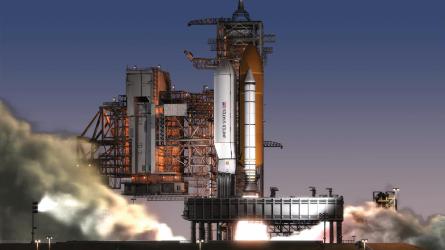A concept almost as old as the Space Shuttle itself is being considered as a replacement for NASA's Constellation programme return-to-the-Moon Ares rockets.
Designs for a Shuttle-derived launcher have existed since the late 1970s, but are being revisited as a funding gap for the Moon return plan conceived by president George Bush has left the Ares V cargo booster on hold and the launch of an astronaut-carrying Ares I years late. Further, president Barack Obama has ordered a review that may end the Ares rockets programme before the 2010 retirement of Shuttle.
|
|
|---|
Above: Artist's impression of a Space Shuttle derived Heavy Lift Vehicle launching from a NASA Kennedy Space Center Shuttle pad |
| From Shuttle to HLV: a 30-year journey The Space Shuttle-derived Heavy Lift Vehicle is the merely the latest concept that uses the Shuttle external tank and solid rocket boosters to orbit robotic spacecraft or cargo with a side-mounted cargo carrier. But HLV is the first NASA proposal to also include a crewed vehicle. Designs for side-mount cargo Shuttle-derived vehicles first appeared in 1979, and "Shuttle-C" version studies were published from 1987. But it was not until 1989, three years after the Space Shuttle Challenger disaster, that the unmanned Shuttle idea gained momentum. That year NASA proposed Shuttle-C, a concept able to place 45,000kg (99,000lb) into low Earth orbit by 1995 but it was not funded. The 2003 loss of the orbiter Columbia renewed interest in the Shuttle-C idea and in 2004 an industry team started developing its own side-mounted cargo carrier version capable of placing 68,000kg into LEO. However, NASA's 2005 Exploration Systems Architecture Study report, which underpins its return-to-the-Moon Constellation programme, rejected side-mounted designs owing to inadequate lift capability. |
|---|
The HLV proposal has cargo-only block one and crew or cargo block two versions. NASA's Orion crew exploration vehicle would be integrated into the top of the block two cargo carrier with a launch abort system sticking out.
Shannon's team estimates that for both blocks $6.6 billion is needed from NASA during fiscal years 2011 to 2015, with the first version flying in 2013 and the second crewed type from 2016. Obama's first NASA budget request, for FY2010, asks for $8.1 billion for the Ares rockets up to just 2014. But in June the House of Representatives cut Moon return by $700 million, down to $3.2 billion, while the US Senate is yet to decide on a figure. Once done a final figure must be negotiated by the two.
Shannon is not expecting extra funds. "Our number one favourite option is to build Ares I and V, but right now there is no money to do that."
Compared with the Ares rockets, Shannon's team's HLV proposal would mean no change to launch complex infrastructure as well as continued use of external tank and solid rocket boosters, which has the advantage of retaining the Shuttle-era industrial base. The $6.6 billion is largely for development of the cargo carrier, but there Shannon cites the reuse of the Space Shuttle Main Engine, also known as the Pratt & Whitney Rocketdyne RS-25, the reuse of orbiter avionics, flight software and other systems.
However, Shannon wants to use an expendable SSME, called RS-25E, for lower life cycle costs. But the challenge of making the SSME expendable saw the Ares project office drop that for the Apollo Saturn V-derived J-2X. Another issue to be resolved is the proximity of the Orion and its launch abort system to the external tank. This one issue saw a side mount crew launcher eliminated from NASA studies in 2005.
| POSSIBLE TIMELINE TO FIRST HLV LAUNCH 2009 Aug/Sept - Review reports |
|---|
Shannon says that for the review a NASA technical team and an independent team will "do a first order technical assessment on cost and schedule and performance". Shannon's staff have provided previous Shuttle-derived launcher analyses and their own HLV data.
If Obama selects HLV, the USA could reach the Moon in the 2020s. A double HLV launch would send Orion and a 28,000kg (61,675lb) lander to lunar orbit rendezvous. But Ares could send a 45,000kg lander designed for a Moonbase. HLV lunar missions would be similar to Apollo's sorties.
Within the review HLV is in competition with the United Launch Alliance Delta IV, the Direct Jupiter rocket, and the Ares rockets. For now Shannon's employer is not ready to back HLV, "[We] looked at a wide variety of launch concepts [in 2005]. NASA concluded the Ares I and V design is the right...system."
Source: Flight International



























